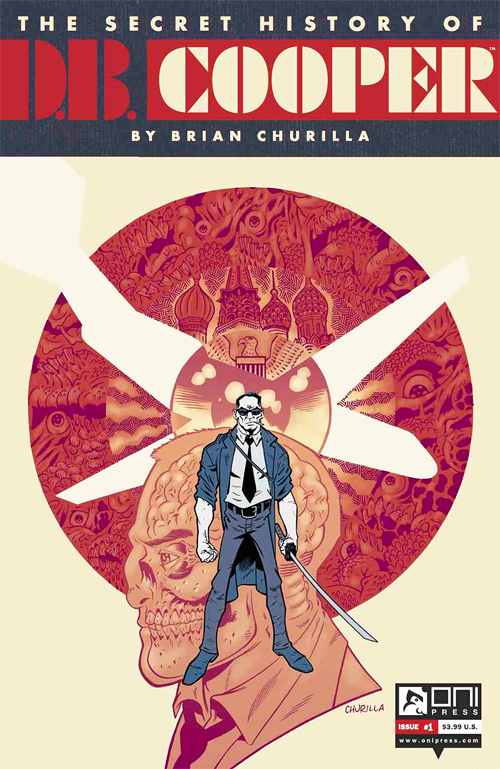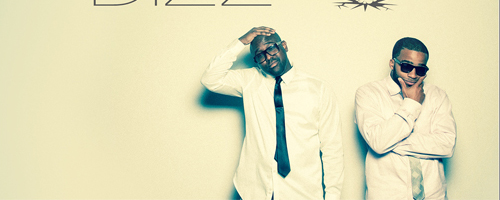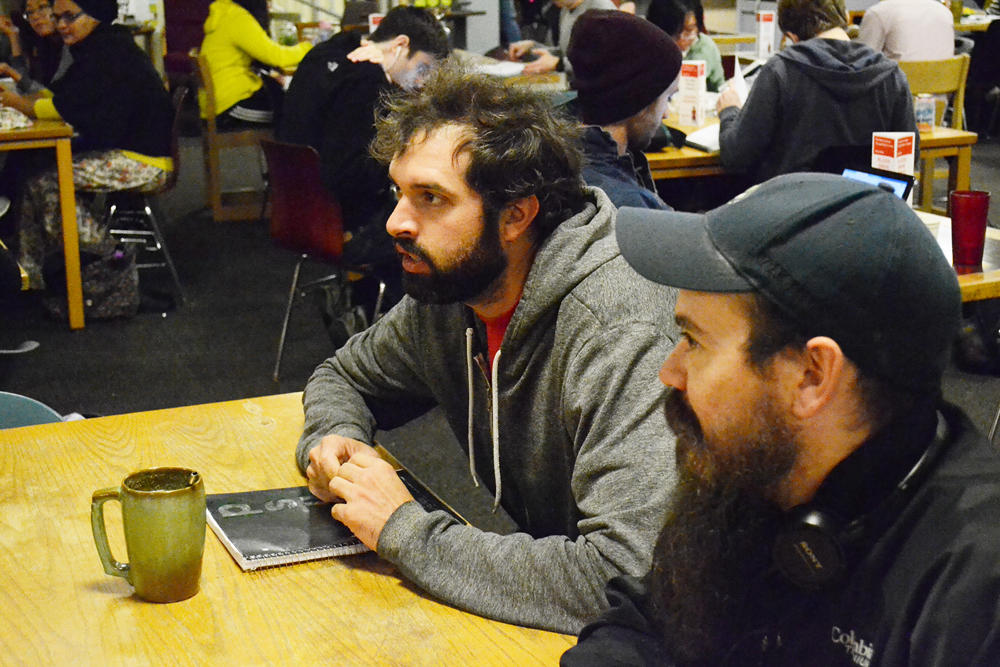Still one of the most popular mysteries in recent memory, the infamous (and unidentified) D.B. Cooper, who hijacked a Boeing 727 and subsequently disappeared, has fueled conspiracy theories for decades.
Interdimensional man of mystery

is exposed in The Secret History of DB Cooper. Photo © ONI PRESS
Still one of the most popular mysteries in recent memory, the infamous (and unidentified) D.B. Cooper, who hijacked a Boeing 727 and subsequently disappeared, has fueled conspiracy theories for decades. Ever since Cooper jumped out of the aircraft mid-flight with a parachute and $200,000 in 1971, countless books, movies and songs have been created in his honor.
The Secret History of D.B. Cooper
Brian Churilla
$29.99
Available at bookstores and comics shops everywhere
It’s only fitting that, since the fugitive’s alias allegedly comes from the name of comic book hero Dan Cooper, the enigma be explored in graphic novel format. Portland publisher Oni Press and local cartoonist Brian Churilla have stepped up to the challenge with The Secret History of D.B. Cooper, and it’s almost definitely not what you’re expecting.
After the first page of historical recapping, we flash back to a week earlier. Cooper awakens not only in a different time but a different plane of existence, an abstract hellscape where eyeballs grow like tulips and grotesque monsters roam the land. He isn’t phased—he’s been here before. They call it The Glut.
There, armed with a sword, Cooper instinctively cuts a path towards his target. The bulbous monster isn’t happy to see him; pretty much everything in The Glut is hostile to our hero, save for a one-eared teddy bear who may or may not be a Soviet agent.
Cooper is a CIA agent—a key player in the Cold War, which still raged in the ’70s. His trips to The Glut are a part of a new kind of experimental psychic warfare. When that bulbous monster eventually gets his head sliced open, a corresponding Soviet official in the real world receives a splitting headache to match.
As the world’s most skilled mental assassin, Cooper is an asset to the CIA, but he suffers from his own personal demons. Estranged from his wife after the disappearance of their daughter, Donna, Cooper has plunged so deep into his work that he’s started hallucinating visions of the girl in The Glut.
The bombastic riff on a historical mystery pushes “based on a true story” to its limits. There’s a lot of creativity here, but the story seems to squander the fertile conspiratorial ground of its hero’s namesake. Not long after we see what really happened on that Northwest flight, the implications are swept under the rug with a few offhand remarks.
The story leaves out a lot of the interesting loose ends of the real-life case, like the hostage release and Cooper’s discarded money, found years later. With such a loose adaptation that involves very few of the actual events, it made me wonder if the story wouldn’t be better served if it were completely free of the D.B. Cooper name.
Beyond that, the book is fun and action-packed, if a bit too reliant on plot twists. It makes more sense in its original serial format; there the twists serve to drive the reader to pick up the next issue. In the collected edition, the twists come one after another a little too quickly, and are either predictable or
relatively inconsequential.
In one case of the latter, a relationship between two of the characters is revealed—but it was only a secret to one other character, who has no reason to care. It comes across as an awkward and forced play for the audience’s sympathy.
Cooper is likable enough, at least, though he suffers from stoic-wiseguy-badass syndrome, a disease for which comics has no known cure.
Churilla also draws and colors his own work, which far outshines his capable writing. The Glut is a wonderful and disgusting place, and it feels fully realized. The creatures are grotesque and ballsy (sometimes literally), and I never felt as though I’d seen the same monster somewhere else before.
The real world is a bit more drab, but Churilla’s exaggerated bodies and facial features lend an air of the ethereal to the comic’s reality.
Colors in both dimensions are vibrant and varied; Churilla really knows how to add depth to his work without letting his coloring do too much of the heavy lifting.
As a cartoonist, Churilla has the benefit of being the sole storyteller (not discounting the work of the editor or letterer). Several times our view flashes back and forth between the events happening simultaneously in the real world and The Glut; these scenes reflect and correspond to each other both in form and in the story.
The transitions are smooth and invisible in one instance and brash and effective in the next. This is all with hardly any verbal cues—the visuals clue the readers in without looking down on them. Churilla makes it look easy.
At $29.99, the oversized hardcover might be a little steep for some. Those looking for a more affordable option might try the digital version from Comixology for $9.99, available on any device with a screen.







